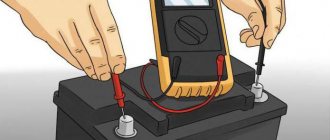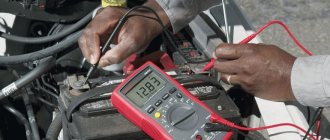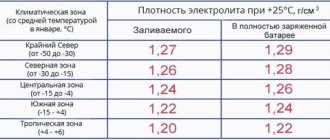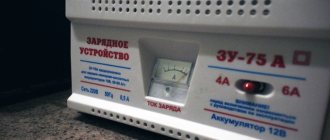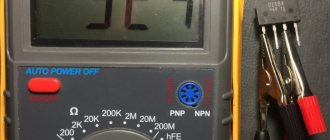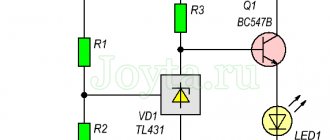Every motorist knows that a lot depends on the power source in the car and it needs to be checked periodically. But few people know how to do this on their own. Modern batteries have special indicators that change color when the battery stops charging normally. But you can only verify whether the indicator readings correspond to reality using diagnostics. To carry out the test, you need to know how and with what to measure the battery capacity.
Methods for determining capacitance indicators
We will describe the most common ways to check the capacity of a car battery. These 2 methods have proven themselves to be the best and are widely used today.
Long Discharge Method
This method has found its application in laboratory conditions. There are also a household method and a method based on long-term charging. Let's take a closer look at all three:
- Standard method (laboratory). To check, the battery must be charged as much as possible and discharged using a minimum current. At the same time, the amount of time during which the discharge occurs is taken into account. The battery capacity, as described above, is nothing more than the product of time and current strength. The complexity of measurements in this case depends on maintaining a constant current discharge using specialized equipment, which is why the method is laboratory.
- Household method. You can check the battery capacity using a constant load. In this case, they use car lamps, creating a load with their help. By analogy with the first method, the time is calculated in parallel in hours. This procedure has its own error, since the load current gradually decreases and the final result of determining the capacitance is not entirely accurate. It is worth noting that the power source should not be allowed to completely discharge, as this may cause it to fail.
- Method based on long-term charging. In this case, an electronic clock and the electrical circuit to which it is connected are used. The diagram itself can be easily found on the Internet. Measurements are carried out over 20 hours.
Method using an electronic tester
This method compares favorably with others in that it is carried out in a shorter period of time. To carry it out, you will need a special device - a tester, which can simultaneously analyze a series of necessary measurements.
The testers operate automatically and do not require special knowledge from the person taking the measurements. Its operating time takes only 10 – 15 seconds. The device easily connects to a power source and has only one button that starts the capacitance measurement process.
The selection of a battery is made based on a comparison of the residual capacity and the nominal capacity, which is indicated by the manufacturer in the battery passport. The difference should not exceed 50%, otherwise such a power source is not ready for further use.
Multimeter method
This device allows you to measure not only battery capacity, but can also be used as an ohmmeter and voltmeter. Measuring the battery capacity with a multimeter is not difficult if you follow the following steps exactly as they are listed below:
- The device must be switched to continuous measurement mode.
- Next, a range is established that is slightly larger than that stated in the battery passport.
- A special black probe is connected to the socket (-).
- The red probe is connected to the socket (+) in the same way.
- The readings are read and displayed.
- At the end of the measurement procedures, the electrical circuit is disconnected.
This text provided comprehensive answers to questions such as: what is needed in order to measure the battery capacity? How to measure? How to find out or how to determine capacitance indicators? The most popular methods and methods of measurement were described. All this information will be useful to every car enthusiast, because knowledge in this area will help in the future when choosing a specific battery. A charger and these skills will keep your power source in working condition much longer.
Battery current measurement
Theoretically, in this way it is possible to measure the actual cold cranking current. According to the IEC standard (to which our GOST R 53165-2008 ), measurements are taken at an electrolyte temperature of minus 18 degrees, when the voltage at the terminals drops to at least 8.4 volts. In practice, the problem is not only how to cool the battery to the desired temperature.
For example, for a battery with a declared current output of 600 amperes, a load with a power of P=U*I=8.4*600=5000 watts will be required. Nowadays, high-power light bulbs are produced mainly in LED versions, and for our purposes, as stated above, they are of little use. If you use devices with a power of, for example, 60 watts, then in this case you will need 84 of them.
If desired, it is possible to assemble a large garland, but the problem of switching large currents will arise so that the contacts do not become welded when closing/opening the circuit. You can adapt the solenoid relay from the car starter for this purpose. You will also have to find a tester with a DC clamp (and such devices are less common and more expensive than AC meters) and with a measurement limit of several hundred amperes. In addition, the measurement will not last long, so you need to make sure that the multimeter has a peak value fixation function.
Checking battery capacity with a multimeter Electrician
How to check the battery capacity with a multimeter
Each lead-acid battery loses its maximum capacity and performance properties over time; a deposit of lead sulphate salts forms on the plates - sulfation. The amount of acid per percentage of electrolyte becomes less and naturally the density of the electrolyte decreases.
How can I check my battery?
Electrolyte density is the oldest and most popular method, but modern sealed batteries do not have holes for checking in this way. With this method you can only learn a little about the general condition of the battery and its immediate future.
Using a load fork. It is a handle with two probe terminals that last for 1 sec. connected to the battery contacts. The device contains a voltmeter scale and a load that is designed for a certain battery capacity (car battery). The device shows the voltage under load and, depending on the readings of its arrow, one could judge the health of the battery.
A lead-acid battery tester is an electronic device that can show many battery parameters in a few seconds (up to 3 seconds), the main ones being: current, voltage, capacity, forecast for battery life.
Test discharge - well, the drawback is that the battery must be fully charged and its operation (discharge) must be checked for a long time against a known load. This takes a lot of time and wastes battery life.
Checking the battery using improvised means
On some models, an even lower current parameter is indicated (for example, this inscription - Initial current less than - 2.1A) based on this, we take this figure 2.1 * 12 volts = 25 Watt - this is the operating load power of the battery.
Now we need a load average between the operating and half of the maximum capacity, this is approximately 35 Watt, if the operating current is not specified, you can take 40 W. A light bulb (but another similar current load is also possible) of 12 volts is best suited as a load and a power of 35-40 W.
So, we connect the light bulb to the battery terminals for a period of 2 minutes and see if the light bulb changes brightness; if the light dims during this time, then the battery is faulty. If everything is unchanged, then after reaching 2 minutes of illumination, we connect a voltmeter (multimeter) to the glowing light bulb. and look at the voltage:
- more than 12.4 volts - the battery has retained its nominal capacity and is fully operational.
- 12-12.4 volts - the battery is serviceable but already tired
- less than 12 volts - the battery has already lost 50% of its rated capacity and it is better to replace it.
You should be sure that the battery is fully charged; it is best to charge it over the course of a day or at least 6 hours with an appropriate current.
Monoblock
You can assemble a battery from individual batteries using a copper wire or a bus bar with terminals. This process, although simple, is still quite labor-intensive, so ready-made monoblocks are made in factories. They consist of several elements assembled in one case made of durable plastic. Monoblock lead-acid batteries typically consist of 6 or 12 individual cells. The voltage is 12 V or 24 V, respectively.
Monoblock
All elements of the monoblock are no different from each other, and they age simultaneously, so the service life of the monoblock is longer than that of each individual battery. In the process of assembling a monoblock, it is possible to use both parallel and serial connections of its individual elements.
Note! Battery life is measured not in years or months, but in the number of charging cycles. To ensure that the battery lasts as long as possible, it is advisable to recharge it after using only a small part of its rated capacity.
How to measure phone battery capacity programmatically
How to find out the manufacturing date of a battery
If you do not have a tester, you can measure the battery capacity of your smartphone using special applications. One of the best options for this is AccuBattery. The free version of the program has wide functionality and can calculate the operating parameters of the battery. You can download it from Google Play.
To test, install the program on your smartphone, and then discharge it until it turns off. Place your device on charge, turn it on and launch the application. In the "Charging" tab at the bottom, set the design capacity specified by the manufacturer if it is not displayed correctly. Leave the device to charge, preferably up to 100%.
When the smartphone is charged, you can go to the “Health” tab in the program. It displays the current capacity indicator, calculated based on data built into the charge controller in the phone. The program automatically calculates the degree of battery wear and displays it.
AccuBattery
If you keep AccuBattery in the background constantly, the application can generate wear graphs so you can determine how quickly the battery in your phone is degrading.
The downside of AccuBattery, like any analogue, is its high dependence on the accuracy of the smartphone’s on-board sensors. After all, calculations are carried out based on the voltmeter and ammeter readings built into the charge controller. If these sensors are inaccurate and distort information, then the final indicators will be incorrect.
Software methods work worst (or rather, do not work) with cheap Chinese smartphones in the price range of about $100. Such devices, in order to reduce costs, are often deprived of full-fledged sensors. If they exist (and any battery controller on a smartphone’s board can measure voltage and current), then there is no access to these sensors from the operating system. In this case, the program will not be able to measure the phone battery capacity.
In addition to testers and programs, there are more accurate ways to measure battery capacity. There are full-fledged testers for taking measurements on batteries disconnected from the smartphone. These are often used for testing, for example, round batteries of 18650, 14500 and the like formats.
LiitoKala Lii-500
By taking measurements with the battery disconnected from the smartphone, you will get the most accurate capacity readings. But since 90% of modern mobile phones are equipped with non-removable batteries that use a cable for connection instead of a contact pad (as was the case before), this method of measuring capacity is not applicable for them.
On which devices can you find out the battery capacity using the methods presented?
You can get information about battery capacity using the options discussed on various devices. The methods help to calculate the battery capacity of a tablet, phone, laptop, car, electric bicycle, UPS and other devices.
An example of calculating battery capacity is presented in the video.
The battery capacity can be calculated at any time of use. The use of one of the methods should depend on the type of device and its power source. The choice is influenced by the required voltage, charging and discharging time. A detailed study of the methodology will allow you to determine values quickly and accurately, avoiding errors and deviations.
What does capacity mean?
Capacity refers to the amount of energy that a battery can store and then deliver to the load. This value is convenient for assessing the condition of the battery and characterizes the level of remaining resource.
Battery capacity decreases over time. This process occurs as a result of chemical reactions, sulfation and destruction of the plates. It can be compared to a decrease in the volume of a vessel due to the adhesion of the substance stored in it to the walls. The degree of reduction of this parameter directly indicates its performance.
Battery capacity is measured in Ampere-hours (Ah). In practice, this means the amount of time a battery is capable of operating at its rated current before being completely discharged. For example, with a capacity of 10 A/h, the battery must continuously deliver a current of 1A for 10 hours or 10A for 1 hour.
Main battery characteristics
Before buying a battery, you need to understand what parameters it must meet. The battery must be compatible with all equipment and the vehicle's electrical system.
Options:
- nominal and reserve electrical capacity;
- starting current;
- power;
- dimensions;
- weight.
Electric capacity is the amount of electricity that can be obtained from a battery when it is discharged for a long time.
There are two types of containers:
- Nominal. To determine this, the battery is discharged at 25°C for 20 hours. For this purpose, a current of 5% of the rated capacity declared by the manufacturer is used.
- The reserve capacity is determined by discharging the battery with a current of 25 A at a temperature of 26 °C. This characteristic shows how long in minutes a car can travel with the generator turned off.
In order to figure out how to determine the power of a battery, you will have to remember physics and electrical engineering. Power is the discharge current multiplied by the average voltage in the electrical circuit (P=I*Y).
The formula shows that with an increase in the power required to start the engine, the average voltage in the car network will drop, and the starter will begin to work more slowly. The starting current of a battery is always directly proportional to its power.
In addition to the starting current, power and battery capacity, it would be useful to pay attention to other necessary parameters:
- polarity of terminals;
- compliance of dimensions;
- fastening.
The condition of the battery and its service life largely depend on the health of the vehicle and operating conditions.
Battery capacity measuring device
Battery capacity is a parameter that determines the amount of energy supplied by the battery at a certain voltage in one hour. It is measured in A/h (Ampere per hour), and depends on which is determined by a special device - a hydrometer. When purchasing a new battery, the manufacturer indicates all technical parameters on the case. But you can determine this value yourself. There are special devices and methods for this.
The easiest way is to take a special tester, for example “Pendant”. This is a modern device for measuring the capacity of a car battery, as well as its voltage. In this case, you will spend a minimum amount of time and get a reliable result. To check, you need to connect the device to the battery terminals and within a few seconds it will determine not only the capacity, but also the battery voltage and the condition of the plates. However, there are other methods for determining battery capacity.
Is it possible to increase the capacity
The battery capacity can be increased only slightly. In general, this process has two sides to the “coin”:
- On the one hand, this is necessary if additional electrical equipment is connected to the on-board network. In addition, in the cold season, the capacity reserve is very useful, because when the air temperature decreases by one degree, the power correspondingly decreases by 1 Ah.
- On the other hand, when not operating in standard mode, the starter is subject to greater wear. And also the generator characteristics may not be sufficient to fully charge the battery.
What affects the battery capacity under real operating conditions?
The actual capacity of a car battery, as a rule, differs from the nominal one. The longer the battery life, the more significant its reduction. There are several reasons that provoke this process:
- terms of Use;
- features of meeting deadlines and service technology;
- battery charging method.
How to check battery capacity with a multimeter
The battery capacity shows how much current the battery can supply to the load over a certain period of time. Let's take a car battery with a capacity of 60 Ah. Such a battery can supply a current of 60 A to the load for 1 hour, or 6 A for 10 hours. Battery capacity is calculated using the formula: E(A)=I(A)*T(h) where,
E is the battery capacity in Ah, I is the current in amperes, T is the battery discharge time in hours.
One multimeter can determine the capacity of any battery. There are several methods to measure battery capacity.
- Checking the battery capacity with a multimeter.
- Checking the battery charge level with a load plug.
- Checking the battery capacity with a SKAT-T-AUTO tester or similar.
- Checking the battery capacity with an electronic load.
It is possible to determine the battery capacity with one multimeter based on the voltage value. However, this value will be very approximate and not entirely reliable. Using a multimeter and one rheostat, you can more accurately calculate the battery capacity. This calculation will be more complete and reliable.
Checking battery capacity with a multimeter and rheostat
The resistance on the rheostat is set to 2-3 Ohms. Connect it to the battery terminals through a multimeter, which is turned on in the current measurement mode of 10 A of the appropriate polarity, and measure the current through a rheostat. If there is only one multimeter, turn it off, set the operating mode to measure 20 V DC voltage and connect it to the battery terminals.
A rheostat is connected to the same terminals. They note the time and wait several hours until the multimeter shows 12 V. That’s it, the process of measuring the battery charge with a multimeter is completed. Now we multiply the time by the current and find the battery capacity.
A more accurate result can be obtained if you use two multimeters or a multimeter and a 10 A ammeter. In this option, the discharge current is measured every hour and recorded. As the battery discharges, the current will decrease. At the end of the experiment, the average value of the discharge current is found (the currents are summed up and divided by the number of measurements), then the average discharge current is multiplied by the discharge time.
Battery charge level at idle after parking the car for 24 hours
The SKAT-T-AUTO battery capacity tester provides results in 15 - 20 seconds. His readings are not highly accurate, approximate. High accuracy results when measuring battery capacity (at a discharge current of 5A - 1.2%) can be obtained by working with an electronic load.
The electronic load is convenient for use by auto electricians and those who like to experiment with batteries, train them and calculate the exact capacity of the battery. For training, the electronic load is set to a discharge current of 4 - 6 A and a voltage of 12V, upon reaching which the audible alarm for the end of battery discharge is activated.
Electronic load for testing the capacity of all types of batteries
Below 12 V this is already a deep discharge and further discharge is not recommended, since there is a possibility of destruction of the plates. Next, charge the battery with a conventional charger to 14.2 V, after charging the battery, repeat the discharge process again.
At the end of the workout, charge the battery, give 2 hours of rest and measure the battery capacity with an electronic load. To measure capacity in A⋅h mode, set the voltage to 12 V and the discharge current to 4-6 A. A sound alarm will notify you of the end of the process. Next, the battery is charged again and installed on the car. This electronic load tests any 6, 12 and 24 V batteries.
Battery life calculation
So how do you calculate battery life? Battery capacity is often indicated in ampere-hours, or mAh. It seems nothing complicated, because you have everything, let’s say, a battery with a capacity (C) of 800 mAh for hours and a device with a current consumption (I) of 100 mAh, which means, according to the formula, it can ensure the operation of this device for 8 hours. So? Not really. The amount of electrical energy that can be extracted from the battery depends on the battery discharge current. That is, with a fairly large discharge current, the battery runs out at lightning speed and releases little energy.
This phenomenon was noticed many years ago, but the first person to try to take it into account quantitatively was Peukert, who modified the formula. According to Peukert, the battery discharge time is equal to, where n is the Peukert exponent. Сp – Peukert capacity. I – discharge current. The value of the Peukert exponent can be determined experimentally. It depends on the type of unit and even on its release. Basically, this value lies in the range from 1.1 to 1.3.
For some batteries, the manufacturer indicates it, but this does not happen often. Basically, you can notice the battery capacity data for different discharge times. This is basically enough to find out the value of the Peukert exponent yourself. So you’ve learned how to calculate how long your battery will last.
How long will the battery last to operate the inverter?
So how do you calculate how long your battery will last? Theoretically, in each specific situation, the operating time of the inverter should be calculated separately, based on the following factors:
- Battery capacities.
- Condition of the unit, level of wear and charge.
- Operating conditions.
- The power of the connected devices and the current they absorb.
- Type of load and volume.
But even if everything is taken into account, it is difficult to accurately calculate the operating time of the inverter. Calculating the battery for an inverter without starting the engine using formulas is often quite inaccurate. First of all, because there is no linear dependence in the drop in battery voltage to the minimum permissible values.
This is all because during the operation of the inverter, the battery is affected by many important factors. But, one way or another, calculation using the formula is quite possible. For example and clarity of calculations of the inverter operating time, we use the following data:
- Battery capacity is 60 ampere-hours.
- Powered device, Lenovo G550 laptop.
Input type voltage, which has 19 watts, absorbed current - 3.42 A, power - 19x3.42 = 64.98 watts (rounded to 65). An inverter for a car most often has an efficiency of about 85%, it turns out that if a load of 100 V is connected to it, then it will absorb 115 V from the battery. We calculate the operating time using the formula T (hour) = Ah (amp-hour) x V ( volts) x N (0.85) x K (coefficient 0.5 or 0.25) / P (V), in which:
- T is the operating time of the connected device in hours. Ah is the vehicle battery capacity per ampere hour. V - min. voltage in volts.
- N - efficiency of the inverter device, take the value of 85%, in the formula - 0.85.
- K - max. percentage of the permissible degree of battery discharge depending on the air temperature: 0.5 or 0.25.
- P is the power of the device connected to the inverter in watts.
The result is: for warm weather conditions: T = 60x11.6x0.85x0.5/65 = 4.5 or four hours and thirty minutes, for sub-zero temperatures: T = 60x12x0.85x0.25/65 = 2.3 or two hours and eighteen minutes.
If you have trouble calculating battery life and don't understand the formulas, use a helper. The calculator will immediately solve all your problems, the main thing is to enter the data correctly.
How to check your phone's battery capacity with a USB tester
As mentioned above, the easiest way to check your phone's battery capacity is to use a USB tester.
USB Safety Tester J7-T
On one side, such a device contains a USB plug, which is inserted into the power supply, and on the other, a USB socket into which the smartphone is connected with a cable. The device also contains a screen on which testing indicators are displayed.
RD UM24C - advanced smartphone battery tester Rd Tech
There are many types of USB testers: from simple ones for a couple of dollars that can only show volts, amps and count mAh - to advanced professional ones that are tens of times more expensive. The latter are often equipped with color screens, can count watt-hours out of the box, support fast charging, take into account efficiency, can be synchronized with a PC to create graphs, etc. To simply check the battery capacity of your phone, a simple device, like the one in the illustration, is enough.
KCX-017
KCX-017 - budget smartphone battery tester Megadevice
To take measurements, discharge your smartphone to zero. Then connect the tester to the charger, connect your device to the tester with a cable, and leave it to charge to 100%. When the battery is charged, the tester will show how much energy is filled into it.
If the device can display watt hours, this is the amount of energy. To convert it to mAh, divide the resulting number by the voltage of 3.8 volts, and multiply by about 0.9 (since efficiency rarely exceeds 90%). That is, if the device shows 10 watt-hours (10 Wh), then (10/3.8)*0.9=2.37 Ah or 2370 mAh is the battery volume. If the capacity stated in the characteristics of the smartphone is 2500 mAh, then the battery wear is about 5%.
If the USB tester only measures mAh, then you need to make allowances for voltage differences. To do this, first multiply the number of mAh by 5 (volts), and then divide the resulting result (this will be milliwatt hours) by 3.8 and multiply by 0.9.
With tester readings of 4669 mAh, the smartphone battery capacity will be 4669*5=23345 mWh, (23345/3.8)*0.9=5529 mAh. That is, although the device indicated only 4669 mAh, the phone’s battery capacity in the units indicated in the specifications is about 5529 mAh.
Shopper.Life
How to connect batteries to increase the total capacity?
To achieve the goal of increasing the technical characteristics of the power source during operation of the device or device, there are options for different connections of the elements of the electrical circuit.
There are two connection methods or schemes:
- Serial connection.
- Parallel connection.
The battery capacity for serial and parallel connections will be different. The first method will increase only the total voltage, and the second will increase the total C b as many times as there are elements in the circuit:
C∑ = C1 + C2
Before starting the experiment, you need to take two battery power supplies with the same degree of wear and charging, and two diodes. For a parallel connection, the minuses of the batteries need to be connected together, and the plus of one to the anode of one diode, plus the other to the anode of the other. The cathodes of the diodes also need to be connected to each other. Turn on the load with a minus at the connection point of the negative terminals of the elements, with a plus at the junction of the diode cathodes. This connection scheme will double C b. It is impossible to assemble such a circuit without diodes, since the batteries will discharge one through the other.
Determining capacity using a charger
The capacity can also be determined using a conventional charger. Having determined the amount of charge current (it is indicated in the characteristics of the device), it is necessary to fully charge the battery and note the time spent on this. Then, multiplying these two values, we get the approximate capacity.
More accurate readings can be obtained using another method, for which you will need a fully charged battery, a stopwatch, a multimeter and a consumer (you can use, for example, a flashlight). We connect the consumer to the battery, and using a multimeter we determine the current consumption (the lower it is, the more reliable the results). We note the time during which the flashlight was shining, and multiply the result obtained by the current consumption.
The most important parameter of each battery is its battery capacity. It determines the amount of energy given to them for each period of time. This applies to all batteries from car to telephone. Knowing about them and understanding the device is important because using the wrong battery capacity can cause serious problems in starting these devices.
Read also: Welding pliers clamp
The units of measurement for this quantity are Amperes or Milliamps/hour. Based on this parameter, the battery for the equipment is selected, guided by the recommended values. If the recommendations are violated, for example, the car may not start in winter.
Car battery
If necessary, you can use a multimeter to check the capacity of the car battery. As a rule, testing is carried out when various problems occur: difficult engine starting, dim headlights, and others. Recommendations for conducting a power source test with the device are as follows:
- First, you should purchase a more suitable measuring device.
- The next step is to select the required load (it should take about 50% of the total current). With a declared capacity of 7 Ah, the load should be approximately 3.5 V, for which a light bulb with a power of about 40 watts is selected.
- During the test, you should wait about two minutes. If it starts to go out quickly, this indicates a poor technical condition of the power source.
- The measuring device is connected without disconnecting the load. The indicator should be at least 12.4 V. It indicates that the battery is in good technical condition. At low values, the energy source needs to be serviced.
We recommend: Methods for restoring a laptop battery: programs and utilities
Too low a voltage is typical for batteries whose capacity is low and the plates have been destroyed. Such power supplies should be replaced promptly, as serious structural changes can lead to a short circuit.
How to make the device yourself
If it is not possible to purchase a ready-made device, you can always assemble a device for measuring battery capacity with your own hands.
To determine the state of charge and capacity of the battery, you can use a load fork. There are many models of ready-made forks on sale, but you can assemble it yourself. One of the options is discussed below.
This model uses an extended scale, which ensures high measurement accuracy. There is a built-in load resistor. The scale is divided into two ranges (0-10 V and 10-15 V), which provides an additional reduction in measurement error. The device also has a 3-volt scale and another measuring device output, making it possible to check individual battery jars. The 15V scale is achieved by reducing the voltage on the diode and zener diode. The device current increases if the voltage value exceeds the opening level of the zener diode. When a voltage of incorrect polarity is applied, the diode performs the protective function.
In the diagram: R1- transfers the required current to the zener diode; R2 and R3 – resistors selected for the M3240 microammeter; R4 – determines the width of the narrow scale range; R5 – load resistance, switched on by toggle switch SB1.
The load current is determined by Ohm's law. Load resistance is taken into account.
Multimeter
If checking with a tester is not suitable and you need to accurately determine the current characteristics, you should switch to using a multimeter.
This is a fairly universal device, but it cannot be used independently to measure the capacity of a car’s starter battery. Here the multimeter acts as one of the components of a comprehensive test.
When measuring capacity with a multimeter, testing a car battery may require a load or a test discharge.
Load test
If we talk about effective schemes for measuring the real capacity of a starter battery for a car, then among them it is worth highlighting testing under load.
A car lamp from a headlight is usually used as a load.
By continuing testing, you can bring the battery to a deep discharge state. And sometimes even the most modern and efficient chargers cannot get rid of it.
When determining the load for capacitance measurement, amperage should be taken into account. With a nominal (nameplate) capacity of 60 Ah, the load should be 30 W
To check the battery capacity under load, you must:
- disconnect the battery from the generator;
- take voltage measurements;
- connect the load;
- let the battery run under load for 1–2 minutes;
- turn it off;
- connect a multimeter;
- take voltage measurements again.
If the multimeter shows 12.4–12.6 V, the battery capacity is maintained at a high level and the battery is functioning normally. If the multimeter shows 12 V or less, the power supply is probably at the limit of its capabilities and needs to be replaced.
There is also a control discharge technique, which is often used to check the capacity.
The multimeter connects to the battery and reads data until the current drops to 50–60% of the rated value. The resulting value is compared with the data from the data sheet. If the difference is large, the battery needs to be replaced.
Checking the battery capacity is not that difficult. But this will require certain equipment, some skills and abilities. If you don’t want to do all this yourself, you can always send the battery for diagnostics. They will check it using all available methods and issue a verdict on the current condition of the battery.
You can extend the battery life. Even if the lead plates have undergone sulfation. But sometimes there is no need to talk about recovery. The only way to return the machine to normal operation is to purchase a new power source.
Indicators of batteries, with which the concept of capacity is inextricably linked
1. Dependence of battery capacity on its discharge current.
This dependence is based on the following fact: when the protected load is connected to the battery without using a converter, the amount of current consumed by the battery remains unchanged. In this case, the operating time of connected electrical consumers will be determined as the ratio of the selected capacity to the consumed current. In a more familiar form, this formula is written as follows:
Q = I T
where Q is the battery capacity, Ah (mAh);
I – constant battery discharge current, A;
T – battery discharge time, hours.
If we are dealing with large amounts of current consumption, then the actual power indicators are often lower than the nominal ones indicated in the passport.
2. Dependence of battery capacity on energy
Today, it is quite common among users that the capacity of a battery is a value that fully characterizes its electrical energy, accumulated by the battery when it is 100% charged. This statement is not entirely correct. Here it is also necessary to make a reservation that the battery’s ability to store energy directly depends on its voltage and the higher it is, the more energy the battery can accumulate. In fact, electrical energy is defined as the product of the charging current, battery voltage and the flow time of this current:
W=I·U·T
where W is the energy accumulated by the battery, J;
U – battery voltage, V;
I – constant battery discharge current, A;
T – battery discharge time, hours.
Based on the fact that the product of current and charging time gives us the battery capacity (as discussed above), it turns out that the electrical energy of the battery is found by multiplying the rated voltage of the battery and its capacity:
W=QU
where W is the energy accumulated by the battery, Wh;
Q – battery capacity, Ah;
U – battery voltage, V.
When several batteries of the same capacity are connected in series, the total indicator of this bundle is equal to the sum of the capacities of all batteries included in its composition. In this case, the energy of the resulting battery pack will be determined as the product of the electricity of one battery and their number.
3. The concept of battery energy capacity
An equally useful indicator for the consumer of rechargeable batteries is their energy capacity, measured in units such as W/cell. This concept characterizes the battery’s ability for a certain short period of time, which most often is no more than 15 minutes, in constant power mode. This indicator is most widespread in the United States, but has recently been gaining popularity among consumers in many other countries. To approximate the calculation of the battery capacity, measured in Ah based on its energy capacity in W/cell for a period of 15 minutes, use the formula:
Q = W/4
where Q is the battery capacity, Ah;
W – energy capacity of the battery, W/cell.
4. The concept of battery reserve capacity
For car batteries, another characteristic is distinguished - reserve capacity, which indicates the battery’s ability to power the electrical equipment of a moving car when the vehicle’s standard generator is not working. This parameter is also better known in the USA and is called “reserve capacity”. It is measured in minutes of battery discharge with a current value of 25 A. To approximate the nominal capacity of the battery based on its reserve capacity indicator, indicated in minutes, you must use the formula:
Q = T/2
where Q is the battery capacity, Ah;
T – battery reserve capacity, min.
Determining battery capacity using a special electronic tester
To quickly determine the battery capacity, you can use special battery capacity testers. The operation of such devices is based on a series of special measurements. To determine the capacity, the tester sends several probe pulses to the connected battery. Having received the return signal, the tester recognizes them and, using a microprocessor, makes the necessary calculations of the battery capacity. The result obtained is displayed on the electronic display of the device.
One of such devices is the SKAT-T-AUTO battery capacity tester.
The SKAT-T-AUTO battery capacity tester is a fully automatic device and does not require special knowledge to carry out measurements. The tester is designed for quick assessment of the technical condition of sealed and non-sealed lead-acid batteries with a rated voltage of 12 V and a rated capacity of 1.0 to 120 Ah.
The battery capacity tester allows you to determine the battery capacity with the accuracy required for battery operation in just 15 seconds. Working with the device is very simple. You need to disconnect the battery from the device in which it is installed, connect it to the tester using special clamps and press just one button.
After determining the residual capacity of the battery, it is compared with the nominal capacity of the new battery indicated in the product passport. If the residual capacity of the battery is less than 50%, then it must be taken out of service and the battery must be restored or replaced.
Read also: Is it possible to degrease with acetone before painting?
Every car owner wonders what kind of device is needed to measure battery capacity. This value is often measured during scheduled maintenance, but it will be useful to learn how to determine it yourself.
